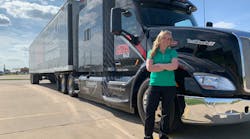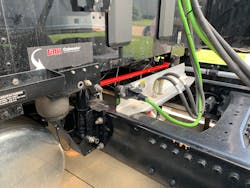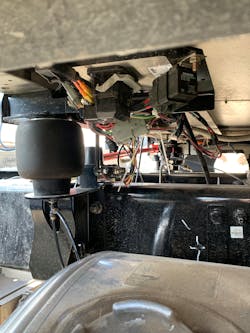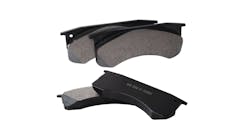Specialty suspension system and component company Link Manufacturing showcased its latest ride comfort technology with the introduction of the ROI Cabmate semi-active cab suspension, designed to further improve ride quality and comfort by limiting the movement of the cab while the vehicle is in operation.
This week, I traveled to Sioux City, Iowa, to try out the new semi-active cab suspension first-hand at Link’s world headquarters. Members of the press received an introduction to the new product technology and the chance to ride and drive a truck equipped with the ROI Cabmate.
I rode in, and drove, Link’s 2016 Peterbilt 579 test truck, hauling a full trailer through the city. The route included four railroad crossings – some of them pretty gnarly – to provide real-world experience on the ride improvements.
How it works
Built off the company’s original Cabmate design, the road-optimized innovations (ROI) technology in the ROI Cabmate uses electronics to assess vehicle movements and road conditions and makes real-time adjustments 200 times per second, according to Michael Hof, vice president of business development for Link.
“It represents a product category designed to enhance the performance of Link’s traditional products through electronics,” Hof says. “Link will incorporate an engineered algorithm into the software that will increase the efficiency of the Link suspension.”
This algorithm will be fine-tuned based on OE specs, dependent on the vehicle make and model. Link currently offers factory installs for the Cabmate in Volvo and Mack Trucks; Paccar, including both Peterbilt and Kenworth nameplates; and Navistar. The Link team hopes to continue building on the OE relationship, to offer their latest cab suspension product as an OE spec.
The ROI Cabmate consists of the traditional mechanical components of a cab suspension system including air springs, shock absorbers, a height control valve, and linkage between the cab and frame, while also incorporating electronics to gather and assess data. The data collection process consists of two sensors – an accelerometer and a position sensor, as well as an electronic control unit (ECU).
The accelerometer monitors the motion of the cab and reacts accordingly, while the position control sensor monitors the position and velocity of the vehicle cab relative to the surroundings.
Data from both sensors is sent to the ECU. Using Link’s proprietary algorithms, the ECU interprets the stream of info and processes in real-time. The entire system operates on less than 10 watts of power.
Once inputs are received from the ECU, the system responds accordingly. This is primarily done through controlling the movement of the shock absorbers.
“The ECU then transmits another signal and … it will send a charge to the shock to either restrict the damping or soften the damping,” Hof explains. “Dependent upon the severity of the event, your height control valve will also inflate or deflate your air spring. It’s a chain reaction that happens 200 times per second.”
A solenoid valve controls the flow of shock absorber fluid, which impacts the damping effects of the shock.
“The shock actually plays a bigger role in the new system than the air spring does [in terms of ride performance],” Hof adds. He explains that traditional cab suspension systems, including the Cabmate, utilize the air spring as the primary suspension component responding to a severe event with the shock absorbers providing additional protection. “It’s a little bit the opposite on the [ROI Cabmate]. The air spring provides the cushion, but the shock is going to control the severe events.”
Link is currently testing two different variations of shock absorbers, and has yet to decide ultimately which they’ll provide as the primary specification. The first option has iron ore metal particles in the shock absorber fluid. An electrical charge is applied to fluid, which causes the fluid to become more viscous in order to stiffen the shock absorber. If less dampening is necessary, less charge is applied. This was the type of shock absorber on the vehicle I drove.
The second variation will adjust the orifice size to allow more or less fluid into the shock absorber.
“The viscosity doesn’t change, but the orifice size does,” explains Bill Ott, vice president of engineering for Link. “With a shock absorber, you’re always pushing fluid through a small hole, and that’s what gives you the damping. You can either make the fluid thicker to make the shocks stiffer, or you can make the hole smaller.”
Ott confirmed there are slight differences between the two, but they provide a similar response. The decision for which shock absorber to go with will likely come down to availability and cost, Ott says.
The ROI Cabmate is considered a semi-active suspension system. A relatively recent addition even to many high-end passenger cars like the Audi A8, a fully active suspension uses an actuator to individually control the wheels independent of the chassis.
A pneumatic suspension system – in place for heavy duty trucks because it more seamlessly incorporates the air compressor already used for air brakes and other suspension components on the vehicle – will not achieve the same level of smoothness as a hydraulic suspension.
But, semi-active suspensions like the ROI Cabmate can still assess dynamic reactions to road conditions and help to better control the damping of the shock absorbers.
Hitting the road
In 2016, Link purchased a Peterbilt 579 80” sleep cab to use for product testing. Already factory installed with Link’s original Cabmate cab suspension, this Peterbilt works well as a test subject to compare the original Cabmate to the ROI Cabmate.
We first took the truck out for a ride with the original Cabmate. Compared to other trucks I’ve ridden in or driven, the ride was already noticeably smoother.
The 6.8-mile test route through Sioux Center includes some decent bumps, and four railroad crossings. Two of those crossings in particular provided some bumps and jolts you’d expect driving an 18-wheeler across uneven terrain. The movement was manageable, but could certainly be noticeable in sustained poor road conditions.
I cannot speak to the long-term benefits of an improved ride since I was only in the vehicle for a total of 60 minutes - for three loops around the track (two riding, one driving). But, while riding along and behind the wheel with the ROI Cabmate, I did notice in particular that the air ride seat never bottomed out, even over the most unruly railroad crossing.
Specifications and serviceability
The test truck is set up to easily swap out components from the Cabmate to the ROI Cabmate. The swap takes about 10 minutes, requiring a bottle jack to raise the cab to change out the shock absorbers, and a quick plug-in of the ECU to convert to the ROI Cabmate.
For a full aftermarket install, Tye Davis, senior engineering and lead engineer for the ROI Cabmate development, says Link is working to create a plug-and-play retrofit option available by mid-next year. The kit would include the accelerometer, electronic positioning and height control sensor, the ECU, the wiring harness, and shock absorbers. Hof suggests the same air springs from a previous cab suspension should be usable on the new system.
"Everything will be in one enclosure, so it can just be a bolt-on kit," Davis adds. "There are four wires that need to be connected to the vehicle."
He estimates a three-hour install time.
When it comes to maintenance and service life of the ROI Cabmate, Davis confirms componentry is similar to traditional cab suspensions. He says considerations were made with the electronics to make the install and service as seamless as possible.
“We tried to minimize the amount of electrical tie-ins that are needed, so there are only four wires to connect [the system],” Davis says. “We’ve minimized that sensor set to just the two: the accelerometer and the position sensor. We’ll be publishing failure mode indicators (FMIs) for scan tools to pick up, so if there is an issue, it’ll be easily diagnosed and easily fixed.”
Davis says the ECU will handle recalibrations of the sensors. Reflashing and programming updates to adjust parameters or update an algorithm, for instance, will also be an option.
What’s next?
The direct benefit for specifying a product like this is to improve driver comfort. The less movement of the vehicle after 11 hours of driving, the less fatigue for someone behind the wheel.
“This product will have a major impact on the overall efficiency of our fleet, and the quality of life for drivers,” says Joel Morrow, head of research and development and lead driver for Ohio-based Proger Transportation. “The truck rides better and the drivers are healthier and more productive.”
Proger was one of four fleets Link has worked with to gather more than one million miles of real-world testing on the ROI Cabmate product.
Morrow believes there are some indirect benefits that may be able to justify the cost of specifying the new technology, including improved fuel efficiency and productivity.
A short-nosed day cab may not provide as smooth of a ride as a long-nosed sleeper. But, with a more stable and even ride, Morrow suggests the ROI Cabmate may allow his fleet to specify shorter wheel bases on trucks without sacrificing ride quality. The shortened space between the trailer and cab may also improve fuel efficiency, not to mention allow an over-the-road truck to have better access for urban and last-mile applications, if necessary.
Also as it relates to fuel efficiency, using an auxiliary power unit (APU) can be a challenge for some drivers.
“One of the main issues is when a driver has the APU on and the engine starts up it shakes up the cab, which can wake the driver up from a dead sleep with adrenaline – but the Link ROI Cabmate may be able to assist. This will hopefully completely stop that cab rock.”
Link looks to continue with additional testing and data collection, to verify the performance of the ROI Cabmate.
“Once we collect the data, I think we can leverage the concept and optimize what we can get out of this thing,” adds Morrow.






